Want to increase organic search traffic to your website? You’re in luck! There are some essential Google Analytics SEO hacks that you can use to give your traffic a bump.
Google Analytics is one of the best SEO measurement tools. If you know how to use Google Analytics for SEO, It can really give you some awesome insights into how to optimize your website to drive more organic search traffic.
In this article, we’ll show you our top 9 Google Analytics SEO hacks to increase your organic traffic.
Can you use Google Analytics for SEO?
Yes! There are many ways you can use Google Analytics for SEO. To get your website ranking in Google search results, you absolutely should be using Google Analytics to measure whether your SEO efforts are paying off.
Use it to measure how your optimization efforts are working, find opportunities to improve your website and sales funnel, inform your content strategy, help with keyword research, and more.
Let’s dive into our tips and hacks for using Google Analytics for SEO.
Google Analytics SEO: Tools, Reports & Hacks
Inside Google Analytics, you’ll find a whole bunch of tools, reports, and hacks that will help you immensely when working on your site’s SEO.
A few of the best Google Analytics SEO reports that we’ll go over in this list include Search Console, referral traffic, landing pages, and campaigns.
Let’s get started.
- Get Detailed Insights from the Queries Report
- Understand Keyword Intent Using the Queries Report
- Track Focus Keyphrase Data in Google Analytics
- Monitor Referral Traffic for Link Opportunities
- Analyze Landing Page Reports to Increase Engagement
- Reduce Loading Time by Analyzing the Site Speed Report
- Use Campaigns to Track Your Traffic
- Set up a Custom Insights Notification
- Monitor Demographic Engagement
Video Walkthrough
1. Get Detailed Insights from the Queries Report
With the Google Search Console Queries report, you can track how many times your pages appeared in Google’s search results and which search terms they appeared for. Plus, you can even track the click-through rate and average ranking of your keywords and pages.
To really get the most out of the Queries report, you’ll want to connect it with Google Analytics. That way, you’ll get queries and clicks data right alongside your other Google Analytics reports.
If you don’t have Search Console and Google Analytics connected yet, you’ll need to do that first. For the full instructions, check out How to Add Google Search Console to WordPress and Analytics.
After the setup, you’ll be able to determine what your organic visitors are looking for on your site by navigating to Reports » Acquisition » Acquisition overview:
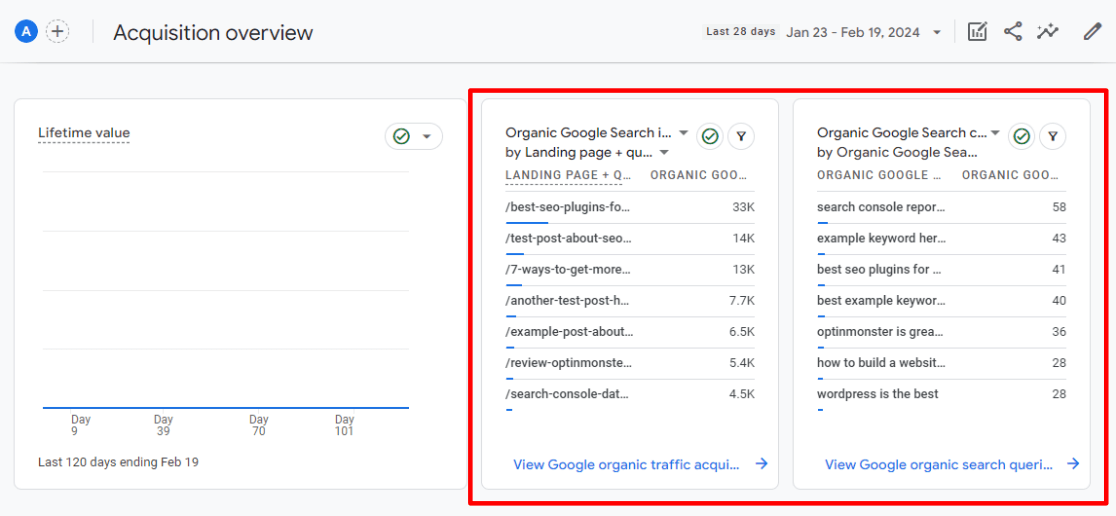
Then, click View Google organic search queries to see the full queries report:
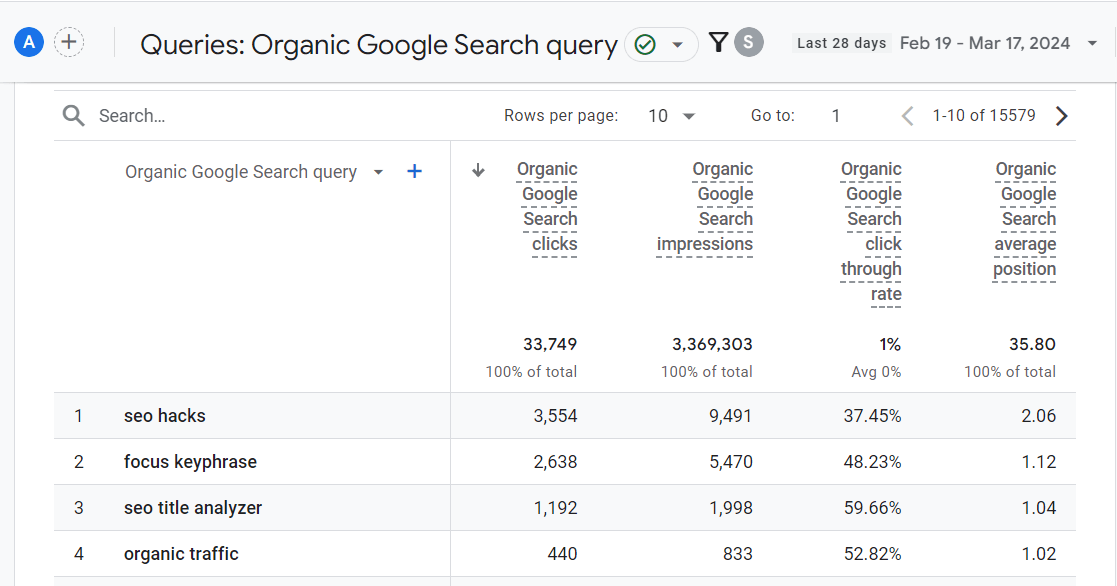
Now, you can use this data to see exactly which terms you’re ranking for and bringing in traffic for, and which ones you need to work on. Take notice of any with a high number of impressions but lower clicks. What can you do to make those more enticing in search results?
Pro tip: WordPress users, get your Queries report right inside your WordPress dashboard with MonsterInsights!
2. Understand Keyword Intent Using the Queries Report
Understanding the intent of your organic visitors is the heart of search engine optimization. Before you dive into finding keywords for your website or do any other SEO hack to optimize your site, it’s worth taking a moment to determine whether you’re driving the right traffic to your site, and if your content really delivers what your organic visitors want.
How can you understand if you’re driving the right traffic?
By looking at keyword intent.
There are four types of keyword intent. They are:
- Navigational, where users search for a particular website.
- Informational, where users search for the answer to a question.
- Investigational, where users search for information that may eventually lead to transaction.
- Transactional, where users are ready to buy.
For example, if you’re a publisher who makes a living by making affiliate sales, you might want to rank your website for investigational keywords. If you’re selling a product, you might want to rank your landing pages for transactional keywords.
The bottom line is, if you want to attract the right traffic and generate sales and revenue, you need to understand keyword intent.
Before you write a piece of content around a certain keyword, run some searches on it first. What kind of content is already ranking? What questions does it answer? What can you write that’s even better, that covers more, but isn’t too off-the-beaten-path?
Grab some examples from your Queries report. Look up one of your landing pages that’s doing really well. What queries is it ranking for? Think about how you’ve mastered search intent there. How can you do that for other content pieces?
For more on search intent, check out How to Master SEO Search Intent to Improve Your Rankings.
3. Track Focus Keyphrase Data in Google Analytics
Are you using the All in One SEO plugin for SEO? Then, you can track the focus keyphrase you set on your blog posts and pages with MonsterInsights. (Alternately, this will also work with Yoast’s Focus Keyword.)
The All in One SEO plugin gives you the option to choose a focus keyphrase on every page of your site, and then gives you suggestions to use it appropriately on that page. Focusing on the right keywords ensures that your site will attract the right visitors that are likely to be converted into leads and customers.
By tracking the performance of your focus keyphrases in Google Analytics, you can identify whether they are attracting the right traffic. It can also give you insights into how to choose the right keyword, and how to pick the content for that keyword.
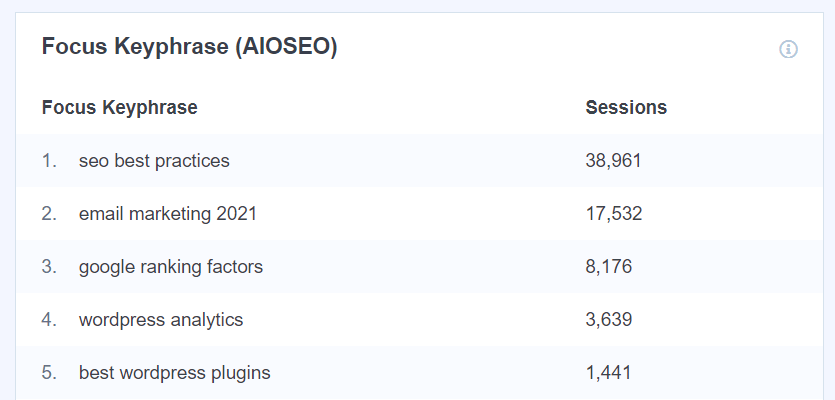
To track the performance of focus keywords, you’ll need to set up MonsterInsights custom dimensions on your site (if you’re using WordPress).
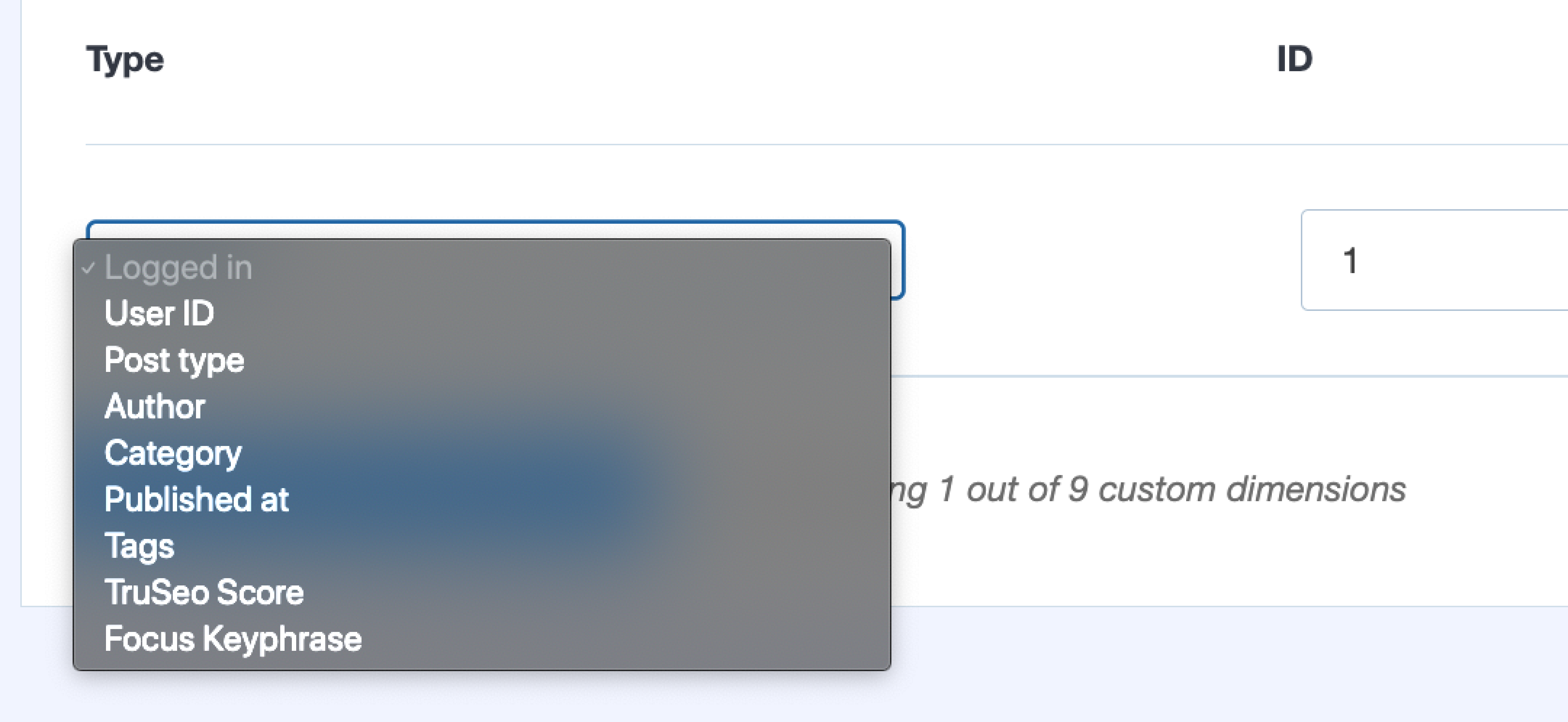
For more details and a step-by-step tutorial on setting this up, check out The Beginners Guide to Custom Dimensions.
4. Monitor Referral Traffic for Link Opportunities
If you’ve started getting some referral traffic to your site, you might want to monitor those links for further link building opportunities.
For example, if you find that someone has linked to a particular blog post of yours, you can reach out to the author and ask them whether they can provide a link to another one of your pages as well. Or, you could send them some other content they might be interested in featuring, or offer to write a guest post for their site.
To find the referral traffic report in Google Analytics 4, you can go to Reports » Acquisition » Traffic Acquisition, then scroll down to the table to find your referral traffic:
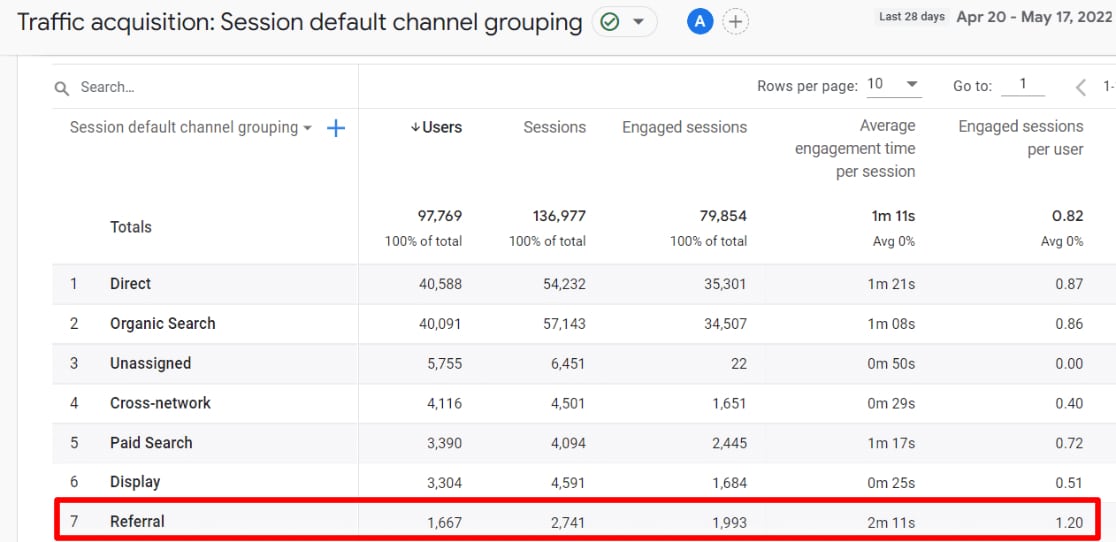
To dive further into where those referrals actually came from, first type “referral” into the search bar to view just the referral traffic:

Then, click the blue plus sign:

From the dropdown, choose Traffic source and then Session source:
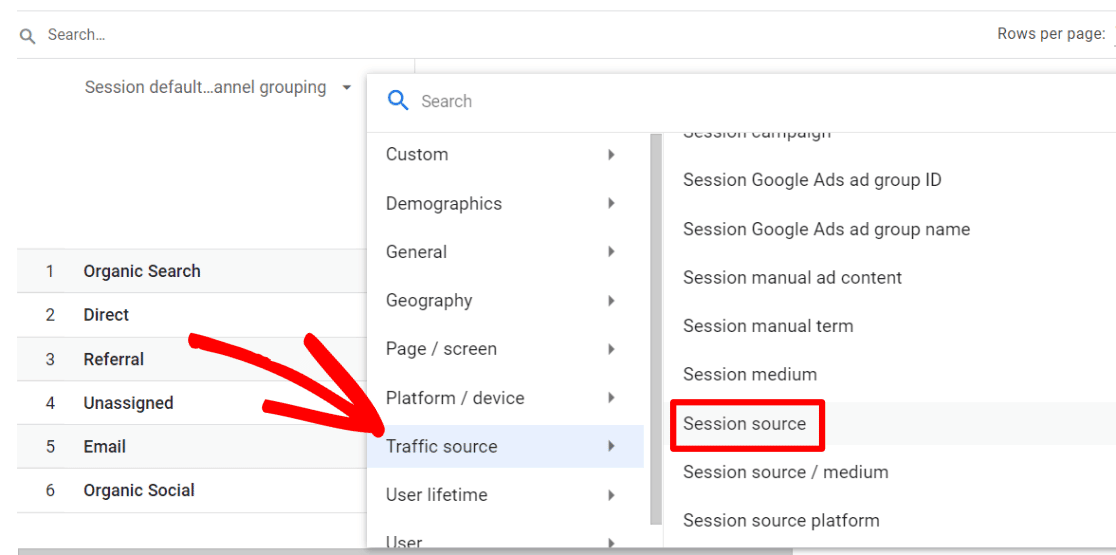
Now, your table will be broken down by how many referrals you got from each referring site:
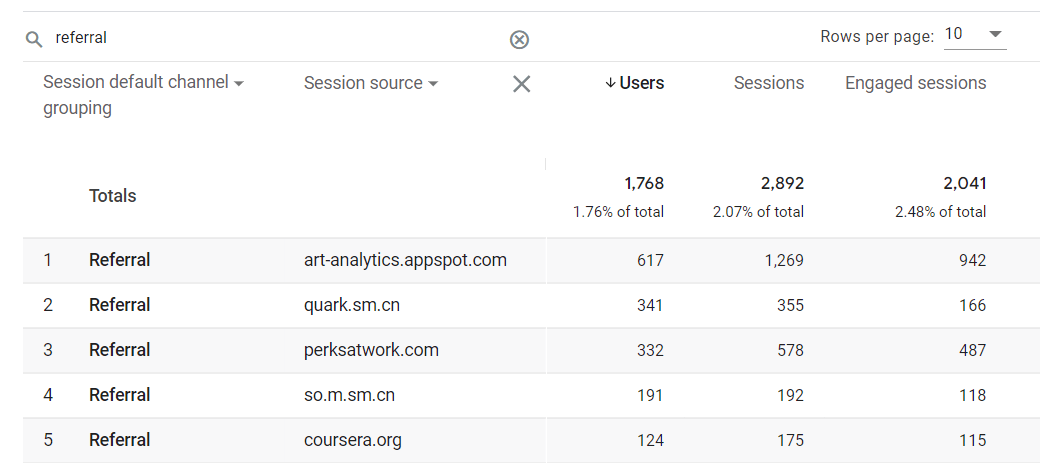
MonsterInsights users can see a top referrals report right in their WordPress dashboard:
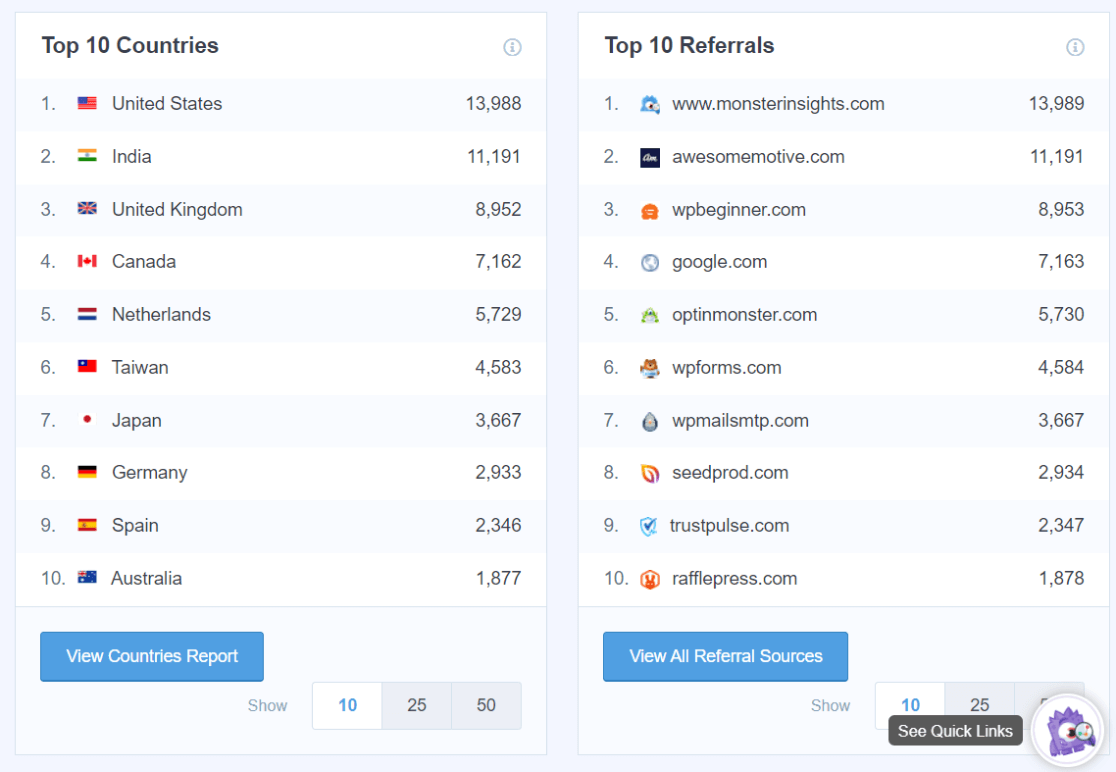
5. Analyze Landing Page Reports to Increase Engagement
Your organic landing pages are the pages where your organic visitors first land on your site. You can analyze how well those pages are working by looking at their click-through rate (CTR), bounce rate, pages per session, and more in the Search Console report.
Find a basic report on your organic landing pages in Google Analytics 4 by setting up Search Console reports, then going to Reports » Acquisition » Traffic acquisition » View Google organic traffic acquisition:
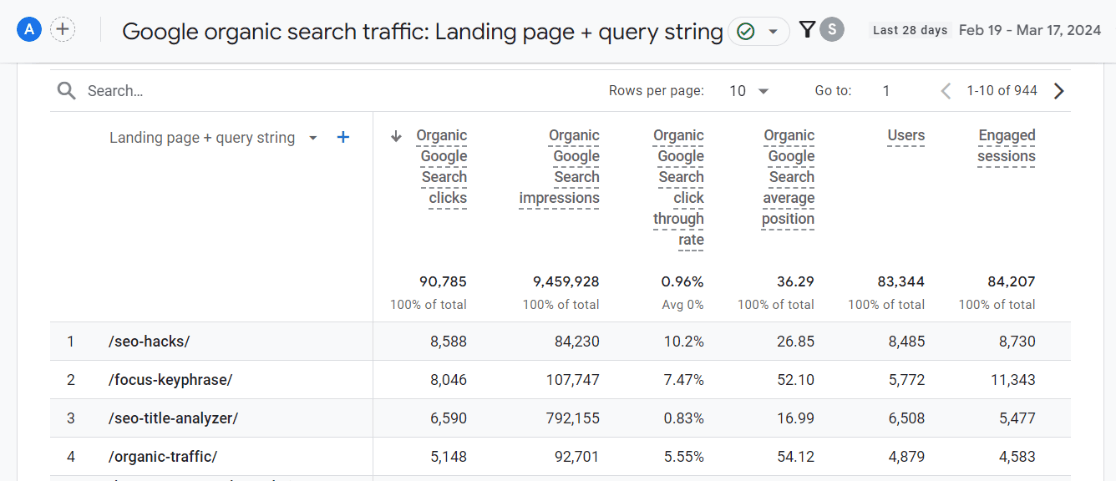
Analyzing your organic landing pages report will give you a clear picture of how your visitors are engaging with your site and how they’re navigating through it. Since engagement signals are organic ranking factors, keeping an eye on the engagement metrics can help you boost your search rankings.
For instance, if Google sends traffic to your page that has a low average engagement time per session, it signals to Google that the organic visitors didn’t get what they wanted from your site. To keep the search rankings intact for your page, you should try to improve those engagement metrics.
6. Reduce Loading Time by Analyzing the Site Speed Report
The speed of your website is an important factor that can make or break your online business.
Google has continued to emphasize the importance of page speed in its algorithm. The speed of your site can also affect how your visitors perceive your brand, and it can cause visitors to leave before even giving your site a chance to load.
Besides SEO, here are a few reasons why a slow website can sabotage your online business:
- The conversion rate can be reduced by 7% if a site is delayed for a second
- 40% of visitors abandon a website that takes more than 3 seconds to load
- 79% of web shoppers would never return to a website if they found any trouble with the website’s performance
Google Analytics 4 does not include a site speed report like Universal Analytics did. Instead, you can find your Core Web Vitals within Search Console:
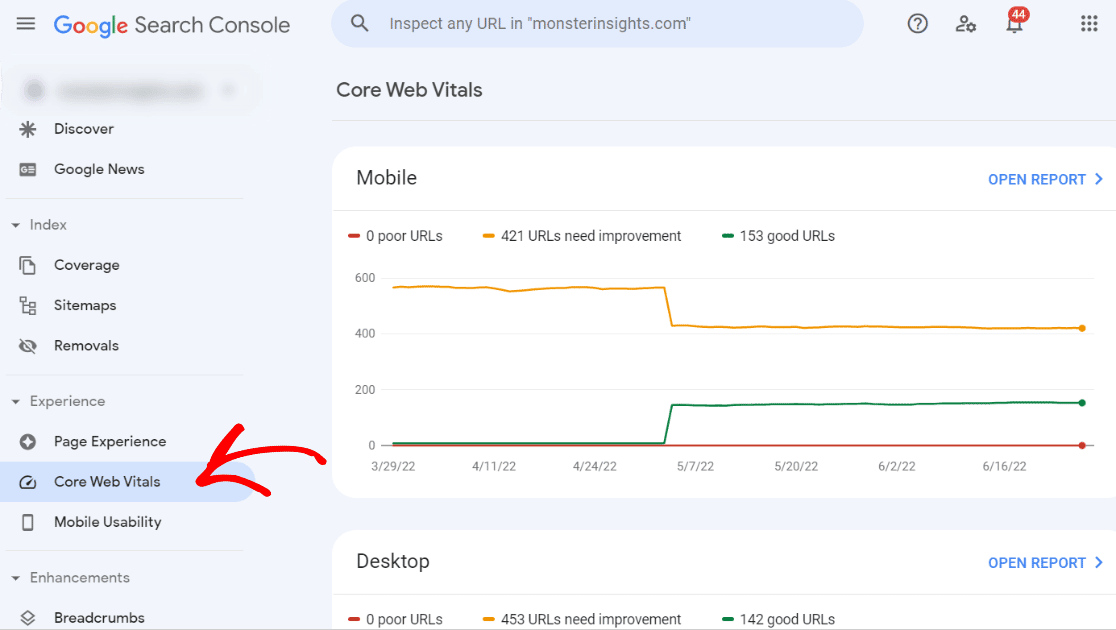
Or, MonsterInsights users, you can access a site speed report any time in your WordPress dashboard:
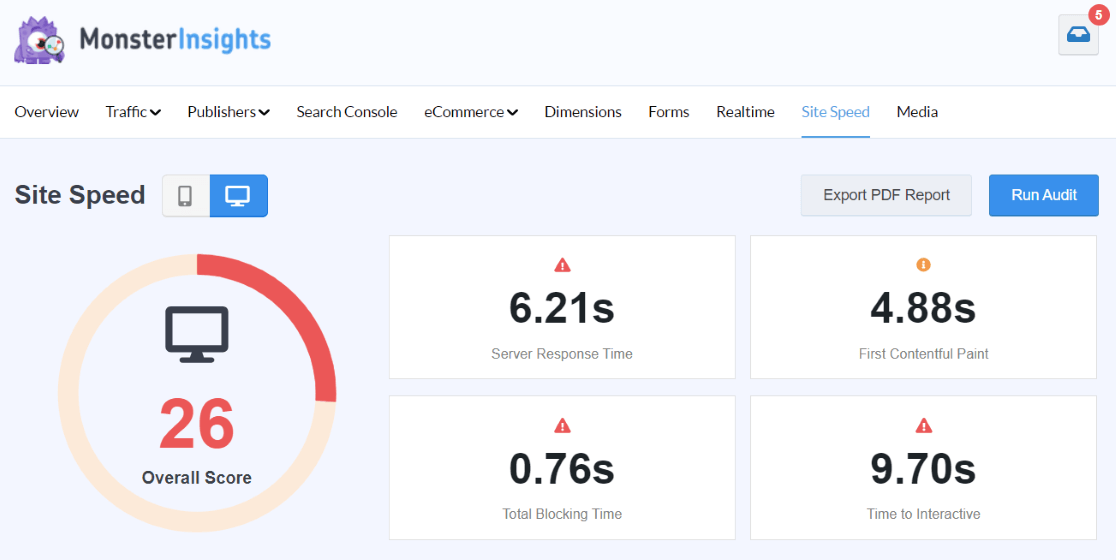
7. Use Campaigns to Track Your Traffic
Campaigns are an awesome way to level up your traffic tracking in Google Analytics. They give you more information about your traffic, so that you can decide what’s working and bring in more of the right kind of visitors.
For instance, let’s say you’re sending out your new content in email newsletters. By using campaigns, you can find out what type of content your email subscribers are the most interested in. If your email subscribers are clicking on a certain type of content the most, that’s a pretty good sign that you should work on really optimizing it and building links to it to help it rank in search.
A campaign works by adding extra parameters (like keywords) called UTM codes to your links that then get tracked in Google Analytics.
So, let’s say you’re sending out a newsletter to your subscribers via Constant Contact. You can use a tool like the MonsterInsights URL Builder to create your custom URL that you’ll share in the newsletter:
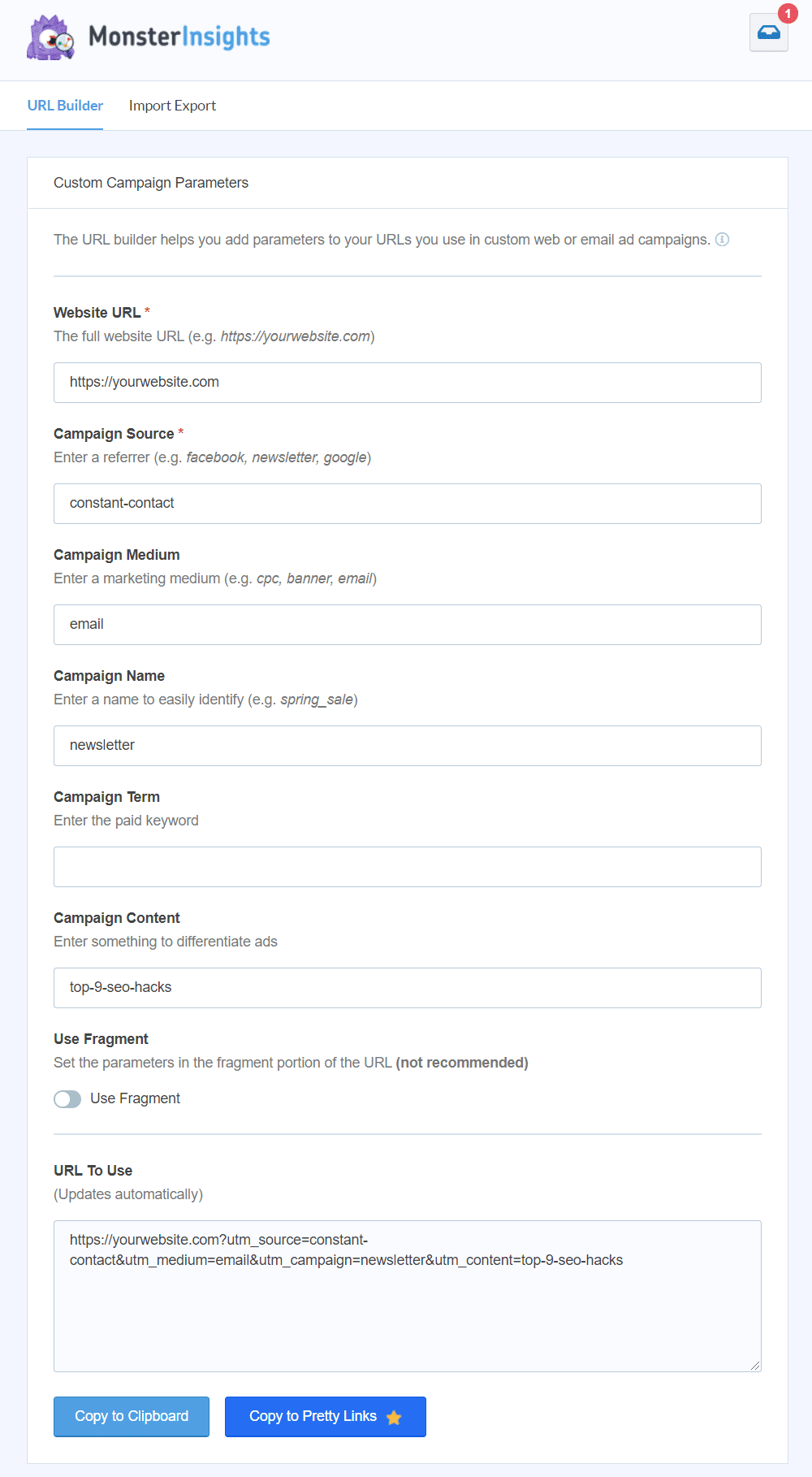
Then, after you get some clicks on that custom URL in your newsletter, you can find the data right inside your WordPress dashboard with MonsterInsights:
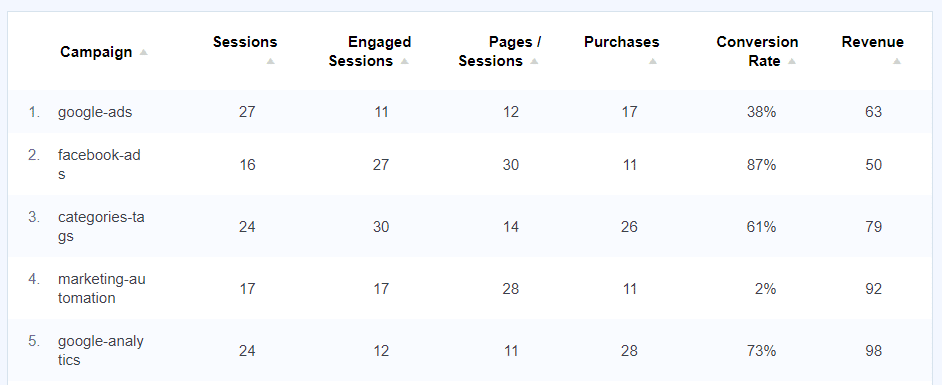
Or, find it in Google Analytics under Acquisition » Traffic Acquisition. Once there, click on the Session default channel grouping dropdown:
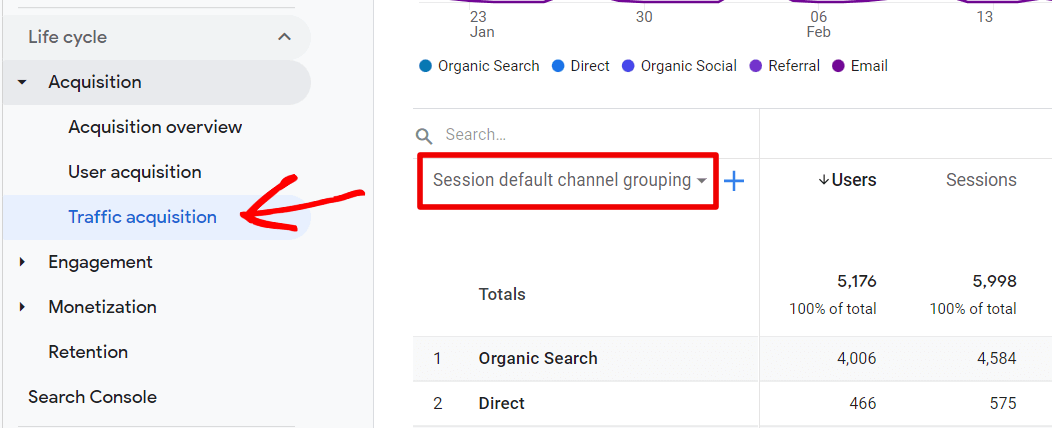
From the dropdown, choose Session campaign:
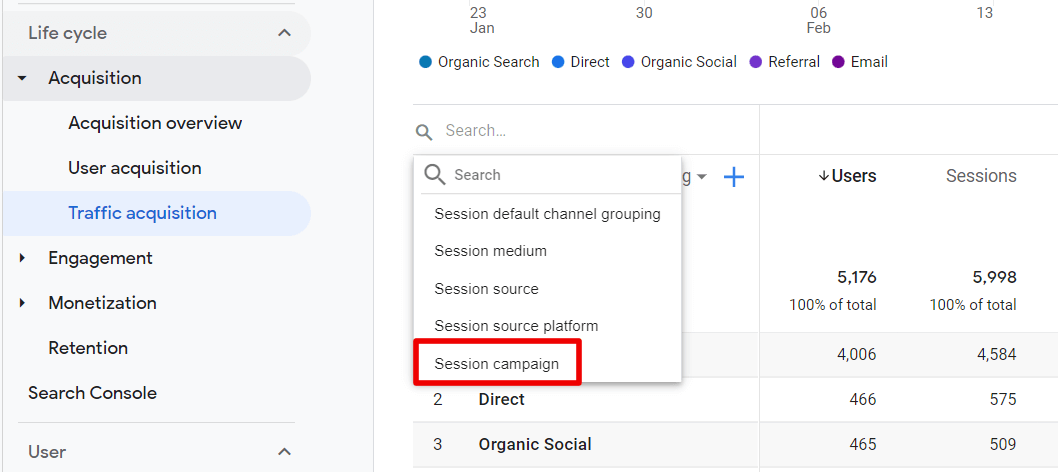
Now, you’ll see your traffic broken down by campaign:
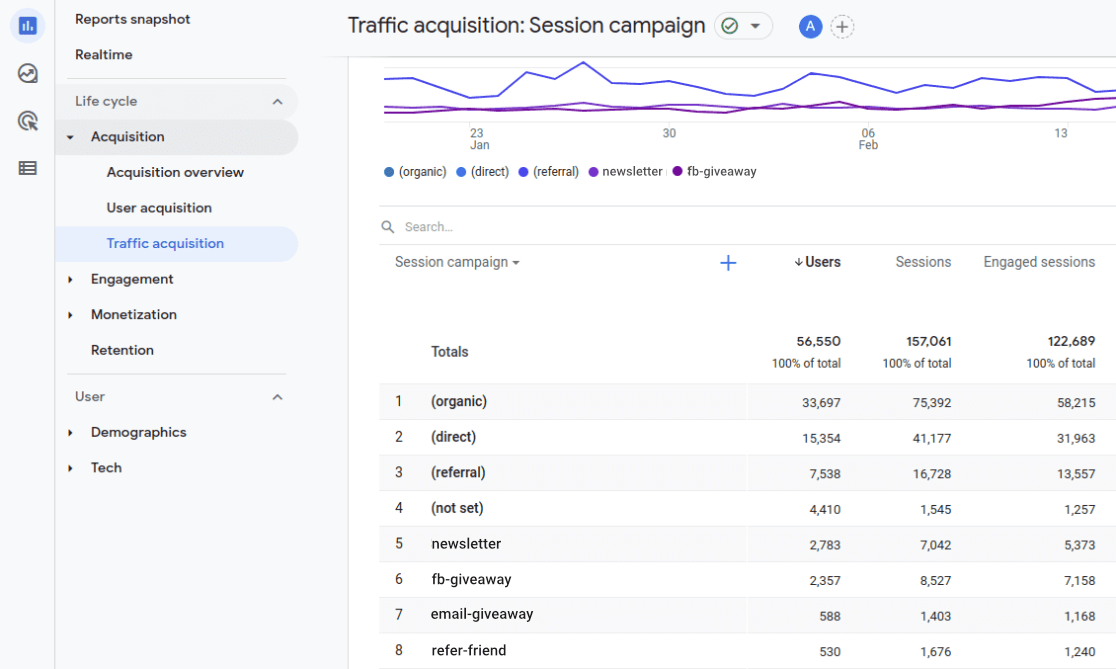
For more information, check out Google’s official GA4 campaign instructions.
8. Set up a Custom Insights Notification
Google is constantly refining its search algorithms, so your organic search traffic is bound to fluctuate from time to time. If your site is affected by an algorithm update and your search traffic drops significantly, or you get a spike in traffic from a certain country, or you get a spike in direct traffic, for instance, you can find out sooner rather than later by setting up a custom insights notification.
With Google Analytics 4, you can set up custom insight notifications that let you know if there’s a significant change in your Analytics reports. That way, you don’t take a few days (or more) to find out that your traffic has been affected by something, and you can fix it before a lot of traffic is lost or skewed.
To set up a custom insights notification, go to the Home tab and scroll down to the Insights section. There, click View all insights:
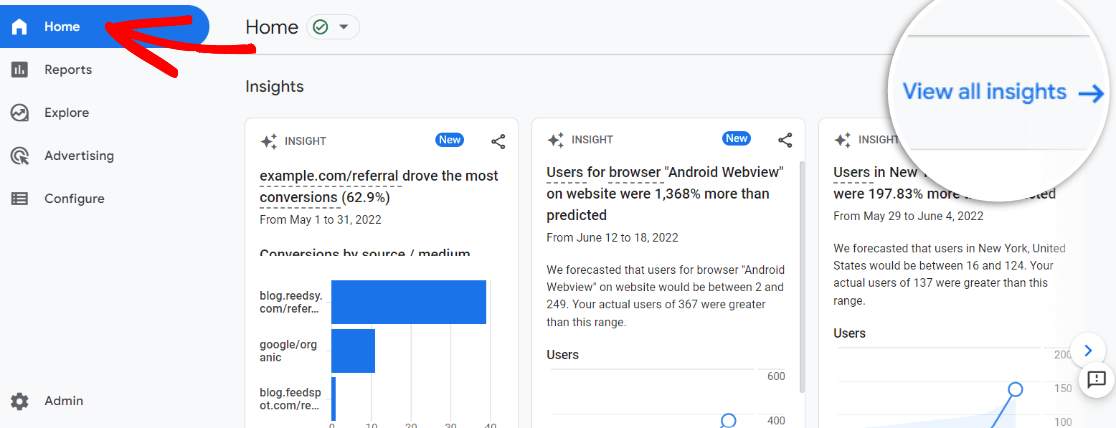
Then, click the blue Create button:
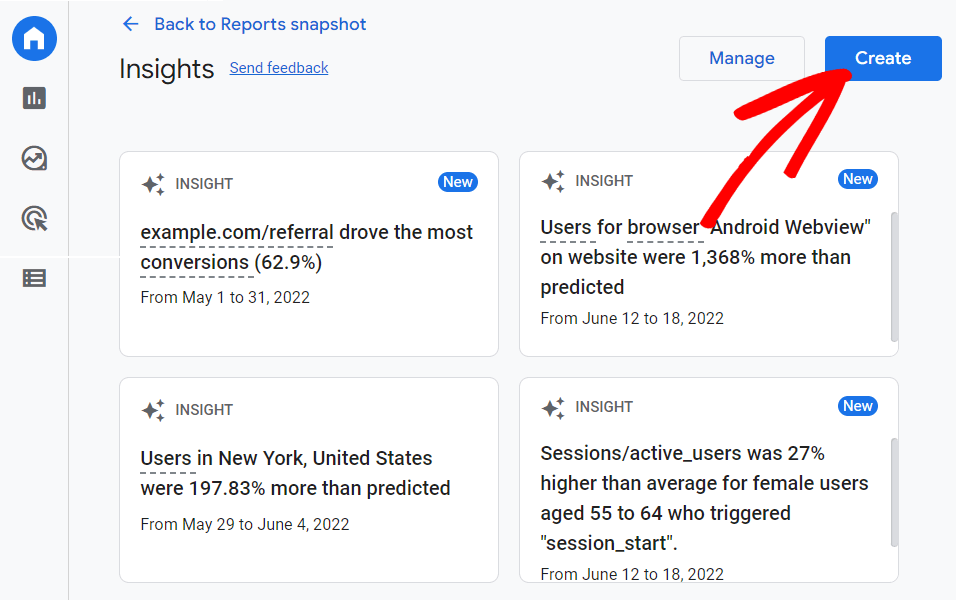
On the next page, Google Analytics will give you a whole list of suggestions, or you can scroll down to create a custom one if you don’t see the one you need.
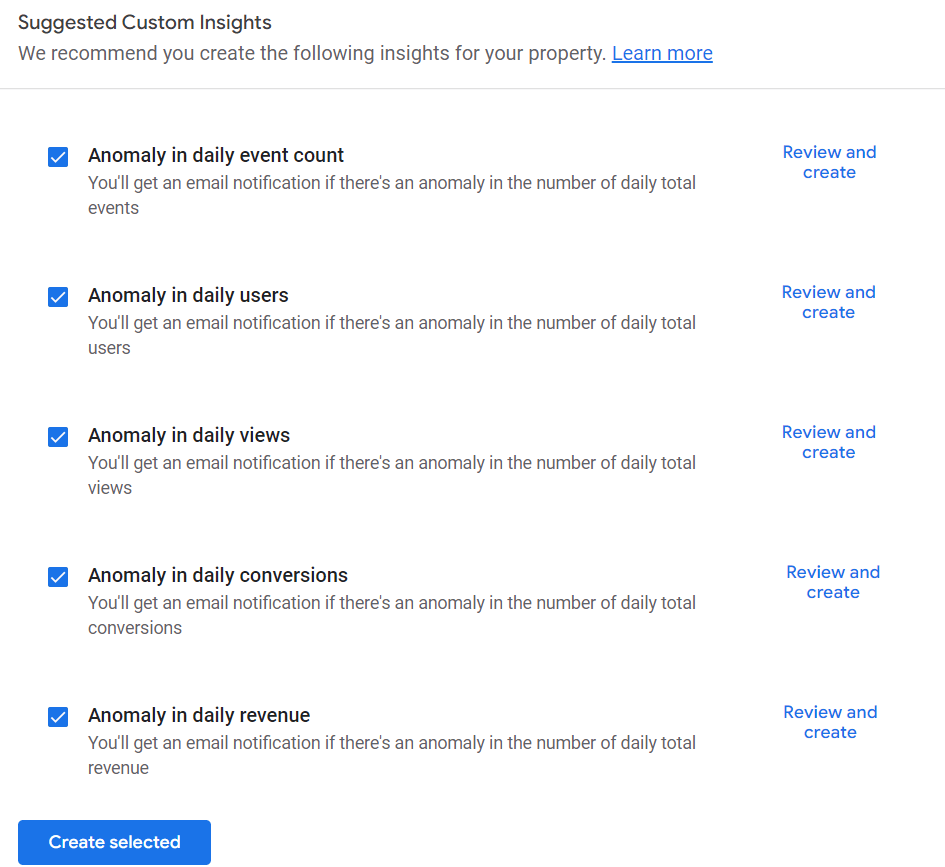
Once you click either Create selected for Google’s suggested insights or create your own, you’ll be all set up to get email alerts.
For a full tutorial on these alerts, check out How to Create Google Analytics Alerts [GA4].
9. Monitor Demographic Engagement
How is traffic from different regions doing on your site? Are you attracting traffic from the right regions?
To find out, open Google Analytics and head to User » Demographics » Demographic details. Then, scroll down to the table. You’ll notice that it’s sorted by Country. To sort it by region or city, click the Country dropdown and choose Region or City:
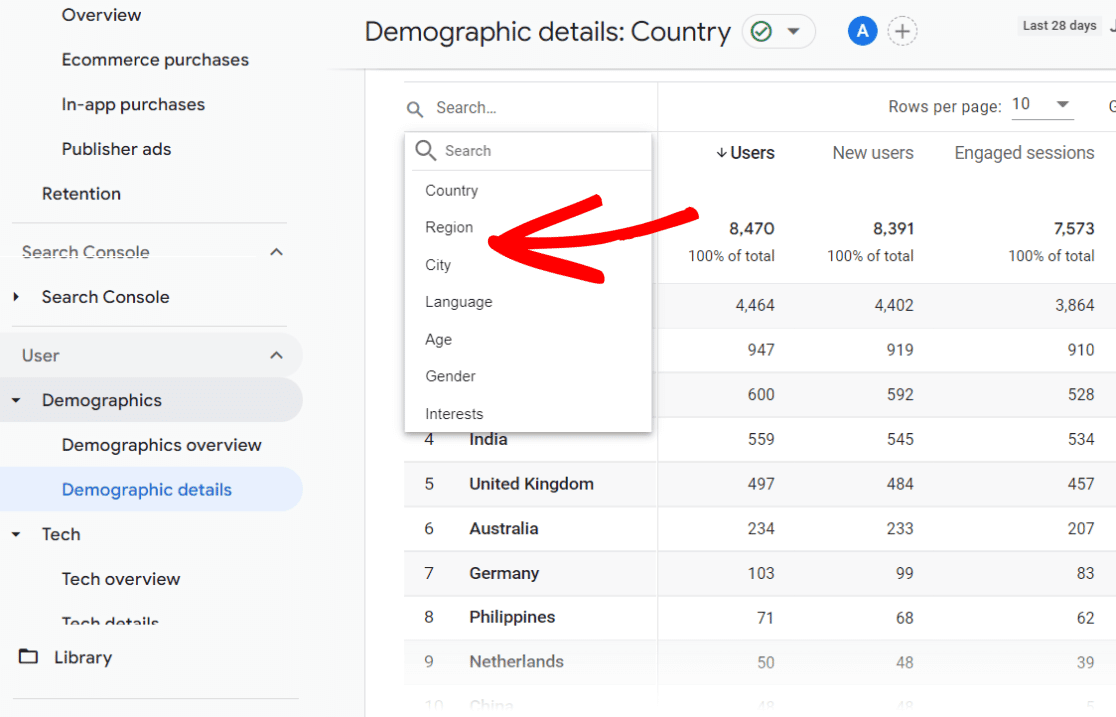
Then, you can see how traffic from those regions or cities is doing on your site. Does one have a shorter engagement time? It might be that those people aren’t finding what they were looking for on your site.
That’s the end of our list!
We hope this guide helped you learn some useful Google Analytics SEO hacks to boost your organic traffic.
If you liked this article, you might want to check out:
What Can You Measure with Google Analytics? Top 11 Metrics
11 Best Free SEO Chrome Extensions to Install Now
How to Add WordPress Internal Links to Improve Your SEO
Blog Post SEO Checklist: How to Write & Optimize Blog Posts
Not using MonsterInsights yet? What are you waiting for?
And don’t forget to follow us on X, Facebook and YouTube for more helpful Google Analytics tutorials and tips.
